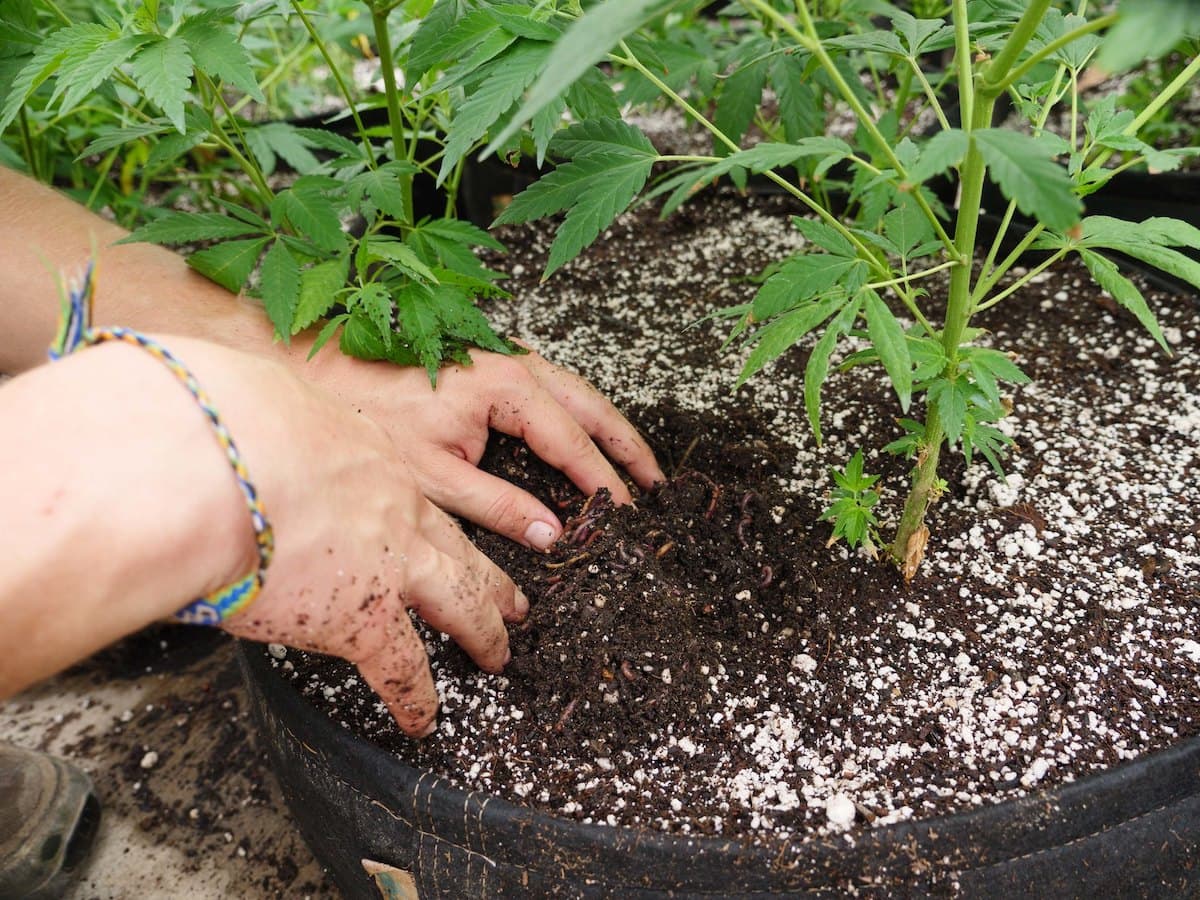
Advice on Organic Grow Mediums
The quality of the cannabis you'll harvest depends on what you use to grow your plants. If you know the differences between the different organic mediums and additives, you'll be able to make better buds.
Roots
When choosing the right medium, you should not only think about the NPK (nitrogen, phosphorus, and potassium) ratios, but also how well the medium holds water and lets air in so that capillary action works well between wet and dry periods. Here is a list of all the different grow mediums you can buy at any grow shop, along with my best advice for making your own organic grow medium.
Soil
You'll need to spend a little more money on a good brand of soil if you want to get good soil. If you've ever bought cheap soil from a hardware store on the corner, you know that it feels like loose dirt. These cheap soils don't hold onto water well, and they don't wick water away very well either.
My best piece of advice is to invest with a well-known company that has good credentials and support from the industry. Some great soil-based products are made by companies like Biobizz and Plagron. Each of these products has perlite and peat moss added to it. You'll want something with a high NPK ratio and lots of trace elements.
Coco
As an organic grower, one of the best things you can do is use coco. Coco can be mixed with other organic materials to make a custom blend, or it can be used in hydroponics because it is an inert medium, which means it has almost no trace minerals or micro minerals. The coco from Canna, on the other hand, has trichoderma added to it, which is a powerful biocontrol agent that keeps harmful fungi away.
Use a mix of 50 percent coco and 50 percent perlite is a good tip. Along with this, you can then add a substrate made of organic matter to give your plants nutrients. This will also make sure that your plants get enough air, and the lightness of this mixture is probably the softest you can get with a fine blend. I also add 50 percent worm guano and compost to my medium to give it the humates it needs. Using coco to grow plants will help their roots and plants grow to their fullest size.
Perlite
Perlite is a small, white material that looks like popcorn and is used to make room in the grow medium. It can also hold on to water and dry out again. This cheap and simple medium doesn't have any nutrients, so it's great to mix with soil, worm guano , or coco at a 50/50 ratio. Some growers have even done hydroponic grows using only perlite.
My best advice is to cover the top layer of the medium with coco or soil if you are top feeding. This is because after an organic feeding, algae will start to grow on the white perlite. The perlite will turn dark green, and the top surface will become dark green and slimy. Just break up the top of the medium to get rid of the algae.
Vermiculite
Vermiculite keeps water in, so there won't be as many dry times between feedings. This is helpful, but you should also try to get some dry times when the plant is growing. When you add vermiculite to a mixture of soil and perlite, the drainage gets better, but if you add too much, the medium stays too wet for a long time. My best tip here is to use it inside propagators to keep the level of moisture high when cloning. If you put a layer of vermiculite on the bottom of the cloning tray, the humidity will stay nice and high inside.
Grow Rocks
These simple but effective additives are used in commercial gardening and landscaping. They are put in hydroponic dripper systems and inside grow mediums to make air chambers. When you buy clay balls from a grow shop or garden center, you'll need to wash them thoroughly until all of the brown dust that looks like sand is gone. When you're setting up your system, you don't want any dust on them.
A good tip is to put at least an inch of clay balls at the bottom of your pots. This will let more water drain out and make sure your pots get enough fresh air. When you feed, you'll see water pouring out of the bottom few inches of the clay balls. This is because water displacement causes oxygen to replace the falling liquid. Also, you can do the same thing on top of the medium by putting an inch-high layer of clay balls there. This will keep algae from growing and help nutrients spread evenly when you feed from the top.
Diatomaceous Earth
This product is easy to spot because it is made of bright chalk-white stone. Diatomaceous earth is often sold as a bug-killing powder. It is naturally high in silicon, which scares away insects and makes leaf tissue stronger against insect attacks.
My tip is to break up the white stones and put a layer of them at the bottom of your medium. This will help the soil drain well and also let the plants' roots grow around the stones. If you mix clay balls with diatomaceous earth, you get the best of both worlds in terms of drainage and silicate availability. Adding a layer of diatomaceous-earth rocks on top is also a good way to keep insects away and provide silicon every time you feed your plants.
Rockwool
This hydroponic medium has no nutritional value at all, so nutrients have to be added to hydroponic systems that use rockwool. Many growers start clones in rockwool and then move them to another system, like a dripper or nutrient-film-technique (NFT) system, where they finish growing. Technically, rockwool isn't organic, and most of the time, plants grown in rockwool are fed with synthetic nutrients. However, it is possible to feed them organic nutrients, so we included it on this list.
When growing with rockwool, especially in hydro, you can always put a second cube on top of the first. Of course, this is when working with 4- or 6-inch rockwool cubes and stacking them to make 8- or 12-inch cubes of packed-out roots—a great way to grow huge yields. As long as the sides of the cubes are covered, the plant can grow roots through the bottom cube and grow even bigger.
Peat Moss
Peat moss is the decaying organic matter left over from sphagnum moss. It is often used by commercial farmers and can be found in bags of growing soil. It's actually a type of compost because it's in the process of turning into humus and minerals are always being leached into the grow medium. Peat moss can hold up to 20 times its own weight in water, so don't use too much water when you use it. It's great for growing plants outside and on a large scale when the soil may not be as moist as you'd like.
Compost
When I was young, I remember digging a hole in the greenhouse, filling it with compost, and putting a seedling or clone in it. As its name suggests, this organic matter is always breaking down. As compost breaks down, all of its micronutrients are released into the grow medium. Beneficial bacteria and plant enzymes play a big role in breaking down carbon-rich organic matter, which turns a dark brown or blackish color.
My suggestion is to mix 25% of good compost and worm guano into your grow medium. This will give you a long-term supply of nutrients that the soil will break down. If you follow my instructions for my own organic mix, you'll find that compost will also make your final medium lighter and give it a better texture.
Organic Additives
Here is a list of things you should be careful about putting into your medium. Once you're happy with how the grow medium looks and feels overall, you'll want to add these products to really supercharge your organic growing medium and send your terpenes and resin production through the roof.
Bat Guano
This is one of the most underrated things used to grow cannabis, but once you try it, you won't go back. I write a lot about how bat guano affects the final taste, and I can easily tell if a flower was grown with or without it.
My best suggestion is to add about 10% bat guano to the final mixture. When bat guano is added to the grow medium, it will support the microbial colony and make the medium full of enzymes. It will also add living humates that will help break down the medium. Based on what they eat (mainly insects or fruits), different bats have different NPK ratios, so try a mix of guanos from different sources. During flowering, feed the plants with a 24-hour compost tea that has been aerated.
Seabird Guano
Seabird guano is great to mix with bat guano. Since seabirds eat fish, their waste has some of the best nutrients for your plants. This guano is high in phosphorus and good for roots. It also has nitrogen, which makes it a great addition during the vegetative stage.
Ash from a volcano
There are many different kinds of volcanic rock for sale at grow shops. This fine black dust is very helpful and is meant to be worked into the medium to improve drainage, air capacity, and capillary action. It's also full of small amounts of elements. My best advice is to put this dark-black powder on the top of your grow medium. So, new roots can grow into the dust from the volcano and start getting the trace elements right away.
Biochar
This is one of the best ingredients, and you can get it for free. You just need to start a fire with wood. The best things to use are branches and logs, and you should let the fire burn without letting the wood turn into ash. Under a microscope, charcoal's crystalline structure is very complicated, so it can hold water better than anything else. It also contains pure carbon.
Here's a tip: break the charcoal into small pieces about the size of a pea, and then mix it into the grow medium as you make your final custom mix. By adding biochar, the grow medium will drain better, get more air, and have a steady supply of carbon for the good bacteria.
Try out my organic blend
Here are the proportions of my own organic mixes for growing plants indoors and outdoors. The outdoor mix is made to last for 6 to 7 months when growing big plants. The indoor mix is made to be used right away. Figure out the ratios based on how many plants you have and how big their pots are. If you follow the instructions, you can make the best organic soil without a lot of work or money.
Indoor Mix:
- 30% coco
40% perlite
30% worm guano
Bat guano
Guano from seabirds Compost - Diatomaceous earth
Liquid Feed:
- Tea with bubbles and fish
Aerated tea: nettles or ortega
Worm guano is aerated tea.
Bat guano in aerated tea (flower)
Molasses without sulphur (entire cycle)
Top Dressing for the Week (Vegetative Stage):
- Worm droppings
- bird droppings
- seabird droppings
- diatomaceous earth
- biochar
Weekly Top Dressing (Flowering Stage):
- Bat droppings
- seabird droppings
- worm guano (weeks 1-3)
Outdoor Mix (Large Plants):
- 20% coco
20% perlite
40% of worm guano
20% vermiculite
Pitch moss
Biochar Bat guano
Seabird guano
Compost
Ash from a volcano and rocks with diatoms
Top Dressing for the Week (Vegetative Stage):
- Worm guano
- bird droppings
- seabird droppings
- diatomaceous earth
- biochar
Weekly Top Dressing (Flowering Stage):
- Bat droppings
- seabird droppings
- worm guano (weeks 1-3)
All of these things can be bought at garden centers, grow shops, or online. Once you've made a blend that is better in terms of organic quality, you'll find that your plants will start to think and act like they're in Hawaii or Indonesia, where the soil is rich and fertile. You'll find that there's a lot more to organic gardening than buying organic nutrients in bottles and pouring them on your soil.



